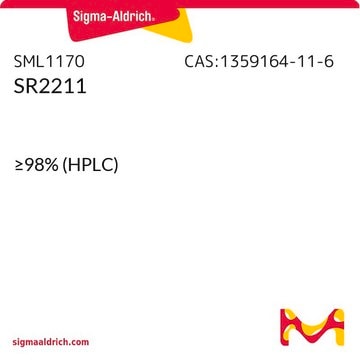475913
Mycophenolic Acid
An immunosuppressive agent that inhibits de novo purine nucleotide synthesis via inhibition of inosine monophosphate dehydrogenase and prevents the formation of XMP and GMP.
Sinónimos:
Mycophenolic Acid, 6-(4-Hydroxy-6-methoxy-7-methyl-3-oxo-5-phthalanyl)-4-methyl-4-hexenoic Acid, MPA
About This Item
Productos recomendados
Nivel de calidad
Análisis
≥95% (HPLC)
formulario
solid
fabricante / nombre comercial
Calbiochem®
condiciones de almacenamiento
OK to freeze
color
white to off-white
solubilidad
0.1 M NaOH: 10 mg/mL
ethanol: soluble
Condiciones de envío
ambient
temp. de almacenamiento
10-30°C
InChI
1S/C17H20O6/c1-9(5-7-13(18)19)4-6-11-15(20)14-12(8-23-17(14)21)10(2)16(11)22-3/h4,20H,5-8H2,1-3H3,(H,18,19)/b9-4+
Clave InChI
HPNSFSBZBAHARI-RUDMXATFSA-N
Descripción general
Acciones bioquímicas o fisiológicas
Inosine monophosphate dehydrogenase
Advertencia
Reconstitución
Otras notas
Senda, M., et al. 1995. Transplantation60, 1143.
Warner-Bartnicki, A.L., et al. 1993. Exp. Cell Res.204, 241.
Falkner, F.G., and Moss, B. 1988. J. Virol.62, 1849.
Cohen, M.B., et al. 1981. J. Biol. Chem.256, 8713.
Mulligan, R.C., and Berg, P. 1981. Proc. Natl. Acad. Sci. USA78, 2072.
Información legal
Palabra de señalización
Danger
Frases de peligro
Consejos de prudencia
Clasificaciones de peligro
Acute Tox. 4 Oral - Aquatic Acute 1 - Aquatic Chronic 1 - Muta. 2 - Repr. 1B - STOT RE 1 Oral
Órganos de actuación
Immune system
Código de clase de almacenamiento
6.1C - Combustible acute toxic Cat.3 / toxic compounds or compounds which causing chronic effects
Clase de riesgo para el agua (WGK)
WGK 3
Punto de inflamabilidad (°F)
Not applicable
Punto de inflamabilidad (°C)
Not applicable
Certificados de análisis (COA)
Busque Certificados de análisis (COA) introduciendo el número de lote del producto. Los números de lote se encuentran en la etiqueta del producto después de las palabras «Lot» o «Batch»
¿Ya tiene este producto?
Encuentre la documentación para los productos que ha comprado recientemente en la Biblioteca de documentos.
Los clientes también vieron
Nuestro equipo de científicos tiene experiencia en todas las áreas de investigación: Ciencias de la vida, Ciencia de los materiales, Síntesis química, Cromatografía, Analítica y muchas otras.
Póngase en contacto con el Servicio técnico










